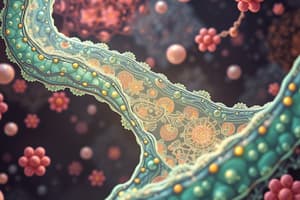Podcast
Questions and Answers
What is the process called when molecules move from an area of higher concentration to an area of lower concentration?
What is the process called when molecules move from an area of higher concentration to an area of lower concentration?
Diffusion
What type of transport requires energy input to move molecules from an area of lower concentration to an area of higher concentration?
What type of transport requires energy input to move molecules from an area of lower concentration to an area of higher concentration?
Active Transport
What is the term for the movement of water molecules from an area of higher concentration to an area of lower concentration through a selectively permeable membrane?
What is the term for the movement of water molecules from an area of higher concentration to an area of lower concentration through a selectively permeable membrane?
Osmosis
What factor increases kinetic energy, leading to faster movement of molecules?
What factor increases kinetic energy, leading to faster movement of molecules?
What drives the movement of molecules from an area of higher concentration to an area of lower concentration?
What drives the movement of molecules from an area of higher concentration to an area of lower concentration?
What is the random movement of particles suspended in a fluid (gas or liquid) due to collisions with surrounding molecules?
What is the random movement of particles suspended in a fluid (gas or liquid) due to collisions with surrounding molecules?
What theory states that molecules are in constant random motion, with greater kinetic energy at higher temperatures?
What theory states that molecules are in constant random motion, with greater kinetic energy at higher temperatures?
What is the importance of movement in cellular processes?
What is the importance of movement in cellular processes?
How does oxygen get from the lungs to the body's cells?
How does oxygen get from the lungs to the body's cells?
What is the process called when waste products are removed from the cell and into the bloodstream for excretion?
What is the process called when waste products are removed from the cell and into the bloodstream for excretion?
Flashcards are hidden until you start studying
Study Notes
Types of Movement
- Diffusion: The random movement of molecules from an area of higher concentration to an area of lower concentration, resulting in uniform distribution.
- Osmosis: The movement of water molecules from an area of higher concentration to an area of lower concentration through a selectively permeable membrane.
- Active Transport: The movement of molecules from an area of lower concentration to an area of higher concentration, requiring energy input.
Factors Affecting Movement
- Temperature: Increased temperature increases kinetic energy, leading to faster movement.
- Concentration Gradient: The difference in concentration between two areas drives the movement of molecules.
- Surface Area: Increased surface area allows for more molecules to interact and move.
- Particle Size: Smaller particles have a greater kinetic energy, making them more prone to movement.
Types of Molecular Movement
- Brownian Motion: The random movement of particles suspended in a fluid (gas or liquid) due to collisions with surrounding molecules.
- Kinetic Molecular Theory: The theory that molecules are in constant random motion, with greater kinetic energy at higher temperatures.
Importance of Movement
- Cellular Processes: Movement of molecules is essential for cellular functions, such as nutrient uptake and waste removal.
- Diffusion of Oxygen: Oxygen diffuses from the lungs to the bloodstream, and then to the body's cells.
- Waste Removal: The movement of waste products out of the cell and into the bloodstream for excretion.
Types of Movement
- Diffusion is the random movement of molecules from an area of higher concentration to an area of lower concentration, resulting in uniform distribution.
- Osmosis is the movement of water molecules from an area of higher concentration to an area of lower concentration through a selectively permeable membrane.
- Active transport is the movement of molecules from an area of lower concentration to an area of higher concentration, requiring energy input.
Factors Affecting Movement
- Temperature increase leads to faster movement due to increased kinetic energy.
- Concentration gradient, the difference in concentration between two areas, drives the movement of molecules.
- Increased surface area allows for more molecules to interact and move.
- Smaller particles have a greater kinetic energy, making them more prone to movement.
Types of Molecular Movement
- Brownian motion is the random movement of particles suspended in a fluid (gas or liquid) due to collisions with surrounding molecules.
- Kinetic molecular theory states that molecules are in constant random motion, with greater kinetic energy at higher temperatures.
Importance of Movement
- Movement of molecules is essential for cellular functions, such as nutrient uptake and waste removal.
- Oxygen diffuses from the lungs to the bloodstream, and then to the body's cells.
- Movement of waste products out of the cell and into the bloodstream is crucial for excretion.
Studying That Suits You
Use AI to generate personalized quizzes and flashcards to suit your learning preferences.



